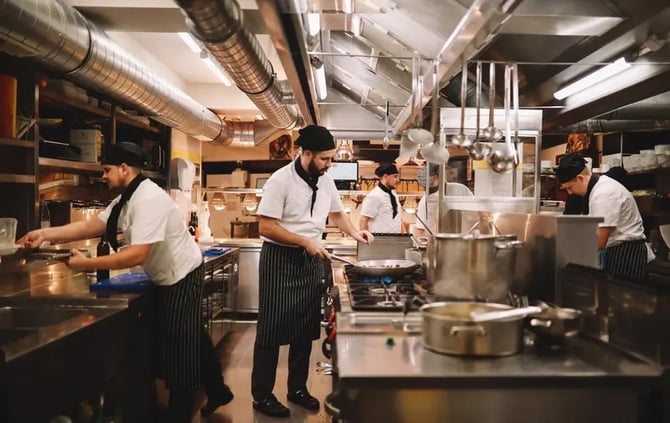Your restaurant’s success is highly dependent on your employees. Happy employees are more likely to be motivated and perform better, while unhappy employees are likely to not do their job properly and leave. A strong team brings consistency to your restaurant operations and helps improve performance and revenue.
However, it can be difficult to keep track of how your team is doing amongst all the other tasks that need to be completed.
This is why many times restaurant managers forget to check up on their employees' well-being and performance, which ends up significantly impacting the restaurant’s overall performance.
How then, do you ensure that you keep a pulse check on all your team members? That’s where regular performance evaluation comes in handy.
Regular performance evaluation paired with an employee evaluation form allows restaurant managers to consistently assess employee performance and be updated about how the employees are doing.
Adding an employee evaluation form to these regular performance evaluations makes the reviews streamlined and even more effective.
Let’s look deeper into performance evaluation using employee evaluation forms.
Key Takeaways
- Introduction: Importance of employee evaluations for restaurant success
- Step 1: Determine evaluation criteria, such as job performance, teamwork, and communication skills
- Step 2: Choose an evaluation method, such as self-assessment, peer review, or manager evaluation
- Step 3: Select a rating scale, such as numerical, descriptive, or behavioral
- Step 4: Include open-ended questions to gather additional feedback and suggestions
- Step 5: Customize the evaluation form to fit the restaurant's needs and goals
- Step 6: Train managers and employees on how to use the evaluation form effectively
- Conclusion: Regular employee evaluations can improve staff performance, retention, and overall restaurant success
Note: A free template for a restaurant employee evaluation form is available for download in the article.
What is a restaurant employee evaluation form?
An employee evaluation form is used to assess and analyze an employee’s performance over a given period of time.
Employee evaluation forms are used by restaurants during performance reviews as a tool to evaluate employees’ current performance and provide clarity about opportunities for development and advancement.
It also gives managers and employees an opportunity to give and receive feedback, and deepen their alignment around expectations.
.webp?width=580&height=366&name=hss-kitchen-workers-1536x972-jpg%20(1).webp)
Why is it important for restaurants to use an employee evaluation form?
1. Clarity of information
The employee evaluation form provides both the manager and the employee a platform to discuss important points like current job role and performance, expectations, any problems or issues, etc. and allows them to share feedback without the fear of consequences.
It also helps the employees better understand which areas they are excelling in and where they need to work better and enhance their skills, which helps them become better at their job and gives them the opportunity to grow.
2. Keep a record of employee performance
The employee evaluation form acts as a written record of each employee’s performance over time. This helps managers to look back and assess an employee’s performance when it’s time for a promotion, or when it’s time to let someone go.
These forms ensure that no details about the employee’s performance are missed during such considerations.
It’s also helpful when new managers join the team, as it makes it easy for them to understand their team by reading their employee evaluation forms.
3. Help employees keep track of their performance
The employee evaluation form also helps employees reflect on their performance over a given period of time and better understand how well they are doing in their role. The form requires them to look back at their achievements and failures, which gives them an opportunity to assess how they have been doing and helps them better understand where they are lacking and what they should be doing to excel and grow in their role.
Important sections to include in an employee evaluation form
Employee information: Name, Job role, Manager
Self-review questions: Include a few questions that allow the employee to analyze their performance. Below are a few examples:
- What are your top three strengths and how did you apply them to your work since your last review?
- What are a few wins you want to celebrate since your last review? What led to those wins?
- Where would you like to improve?
- What are some opportunities for growth to focus on before your next review? What next steps do you want to take?
Feedback questions: Include a few questions that allow the employees to share honest feedback about their team and manager. Below are a few examples:
- Do you feel comfortable asking questions to your manager?
- How do you feel about working with your team?
- Any general feedback you would like to share?
How to conduct an employee evaluation at your restaurant?
1. Create a timeline
The performance review process includes various steps. Before you begin, devise a proper timeline that clarifies the dates for each step. This will make it easier to communicate with your team, and also make the process more streamlined.
Make sure to include enough time in the schedule for the managers and employees to be able to complete their evaluation forms. Usually, the team should be given 7-10 days to complete their evaluation using the timeline templates.
Here’s a sample employee evaluation timeline to help you out:
- Day 1-10: Self-evaluation
- Day 11-17: Manager evaluation
- Day 17-30: Final performance reviews
2. Inform and educate employees about performance reviews
Before you begin the evaluation process, educate your team about performance reviews and the purpose behind them. Don’t forget to set clear expectations and explain timelines so that the process goes smoothly.
You should also give your team time to ask any questions and clear their doubts before the performance reviews begin.
3. Share an employee evaluation form for self-evaluation
The first step in the performance review is self-evaluation. Hand over the employee evaluation forms to the employees and inform them about the expectations and the submission deadline.
The employee evaluation form should include sections where the employee can openly share their thoughts and opinions.
It’s also important to clarify that the evaluations will be free of any discrimination and bias from the manager’s side.
4. Share an employee evaluation form for manager evaluation
The next step of the process is the manager’s evaluation of the employee. Both the manager and the employee answer the same questions about the employee’s performance in the evaluation form, which is then discussed in the 1-on-1 performance review sessions.
It’s a good idea to look back at the employee’s previous performance reviews (if available) and revise the goals that were set for them to be achieved in the given period of time. This will help you better understand how the employee’s performance has evolved since their last review.
Make sure that your review is based solely on the employee’s performance and is not influenced by any favoritism or bias.
5. Schedule 1-on-1 sessions for reviewing evaluation forms
Once both the self and manager reviews are completed, it’s time to start scheduling 1-on-1 sessions for each employee with their respective manager to review the employee’s performance.
The manager should use the 1-on-1 sessions to analyze the employee’s self-evaluation form and discuss their own evaluation of their performance.
The manager should also be open to feedback and use this time to better understand any problems and issues the employee might be facing.
6. Come up with a plan of action for the future based on feedback
Once the review is complete, the manager and employee should be clear about the upcoming goals and expectations. They should then work together to devise a plan of action for the future based on the discussed feedback and goals.
For instance, if the employee is lacking in a certain skill, the manager can set up training sessions to help them improve.
If the performance review has resulted in a promotion or raise, the manager should follow through and provide the employee with all the details and the new contract for their promotion.
Ready to get started with employee evaluation at your restaurant? Download our free employee evaluation form template to get started now!















-1.png?width=1812&height=1072&name=TripAdvisor%20%26%20More%20Bookings%20(1)-1.png)
-2.png?width=1812&height=1072&name=Google%20Bookings%20(1)-2.png)


-1.png?width=200&name=TripAdvisor%20%26%20More%20Bookings%20(1)-1.png)
-2.png?width=200&name=Google%20Bookings%20(1)-2.png)
-1.png?width=200&name=Instagram%20Bookings%20(1)-1.png)
-1-png.webp?width=200&name=Facebook%20Integration%20Rectangle%20(1)-1-png.webp)







.webp?width=200&name=download%20(1).webp)
%20(1)-2.webp?width=200&name=Eat%20(34)%20(1)-2.webp)
%20(1)-2.webp?width=200&name=Eat%20(18)%20(1)-2.webp)









.webp?width=314&height=175&name=Chit%20Printer%20Banner%20(8).webp)



.webp?width=144&height=72&name=Eat%20App%20Logo%20(3).webp)